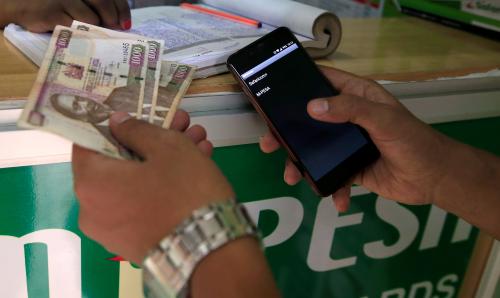Recently on Future Development, authors analyzed different arguments for and against universal basic income, including on the topics of how to better use oil revenues, universal versus targeted social programs, ending extreme poverty, providing basis needs, and boosting financial inclusion and transparency.
Striking a balance between global and local responsibilities frames a defining challenge of our time. Many countries’ international budgets are under threat, leaving urgent priorities underfunded—ranging from famine relief to girls’ education to low-carbon infrastructure for economic growth. Yet underlying economic progress is still creating bright spots on the international horizon. Dozens of countries could eliminate extreme poverty in short order, for example, without a penny of extra foreign aid required.
This assertion draws partly from the new World Poverty Clock, a real-time estimate of the number of people living in extreme poverty around the globe. The clock suggests extreme poverty has declined to afflict less than 9 percent of humanity, around 650 million people, spread across more than 120 countries.
Another part of the assertion draws from the work of GiveDirectly, a non-profit enterprise pioneering unconditional cash transfers in some of the world’s poorest communities. Alongside a growing body of independent academic research, the organization has been using its annual budget of around $40 million to demonstrate the lasting benefits of simply giving poor people small amounts of money.
Last year GiveDirectly launched an East African project piloting a guaranteed basic income, in which people receive transfers worth a little more than 50 cents per day, or $200 per year. When translated to purchasing power parity terms, this is roughly the amount required to raise incomes above the global extreme poverty line. Let’s call these EPECTs—extreme poverty-ending cash transfers.
As a practical thought experiment, what if all of the world’s 650 million people in extreme poverty received EPECTs? Economists like me would typically ask such a question in the context of foreign aid debates. But the challenge needs to be addressed from the other side of the equation too: how many countries could afford to implement EPECTs themselves?
Consider, for example, if countries were to implement their own EPECTs when the total cost adds up to less than 1 percent of gross national income. Drawing from the poverty clock’s country-level data, some rough number crunching suggests that as many as 66 countries with extreme poverty could potentially afford this today. As shown in Figure 1, this would help reach around 185 million people living in extreme poverty, more than a quarter of the world’s current total. It includes around 100 million people in India, 17 million in Indonesia, and 9 million in Brazil, among other countries.
Figure 1: Assessing affordability of extreme poverty-ending cash transfers (EPECTs) in 2017 (est.)

Costs beyond 1 percent of national income are likely too expensive for poor countries where government revenues are typically equivalent to about 10 to 15 percent of the overall economy. Those budgets already need to cover an array of crucial expenditures like hospitals, schools, roads, courts, and police, separate from any direct transfers. For the sake of illustration, the middle bar in Figure 1 shows that around 150 million extremely poor people live in countries where EPECTs would cost somewhere between 1 and 5 percent of national income. This includes some populous countries like Bangladesh, where the cost would be around 1.1 percent of national income, and Nigeria, where it would be around 2.9 percent.
None of this should be interpreted as an argument against foreign aid, which merits ardent ongoing defense. Underscoring the depth of the poverty challenge faced in many places, the same calculations show that approximately 300 million extremely poor people live in 31 countries where EPECTs would require at least 5 percent of national income. In Burundi, for example, poverty is so pervasive and the economy so small that the required transfers would be equivalent to around two-thirds of national income.
To be sure, this thought experiment is subject to important caveats. First, the efficacy and impact of cash transfers will differ across contexts. Second, the estimates exclude administrative systems for transfer delivery. Those costs are not zero, although they are low and declining thanks to the diffusion of digital technologies.
Third, the figures ignore the costs of identifying the poorest people in each country. These too are not trivial, but India’s recent success in issuing more than a billion digital identity cards shows the viability of connecting to vast populations in need. Fourth, the estimates only address one dimension of living in extreme poverty—income—without considering other crucial public services like education, health, roads, and public safety systems that societies require in order to support long-term prosperity.
These qualifiers should not obscure the core insight: a large and growing number of countries could quickly take the lead in ending their own extreme income poverty. A mix of domestic and peer country pressure is needed to focus efforts.
To that end, the world needs a near-term global target to reduce extreme poverty by, say, 25 percent by 2020. That would be a stepping-stone toward the first Sustainable Development Goal, affirmed by all countries, to eliminate extreme poverty by 2030.
The World Bank has assumed headline responsibility for ensuring achievement of the global goal, and thereby has a unique obligation to help all countries with extreme poverty explore their own cash transfer programs. Whether EPECTs are financed domestically or externally, the bank can help each country figure out the best ways to launch scaled programs and share lessons quickly across geographies.
There are no silver bullets in the fight against extreme poverty, but cash transfers have shown themselves to be a powerful weapon in the arsenal. A large and growing number of countries could now deploy it on their own terms.







Commentary
How many countries could end extreme poverty tomorrow?
June 1, 2017